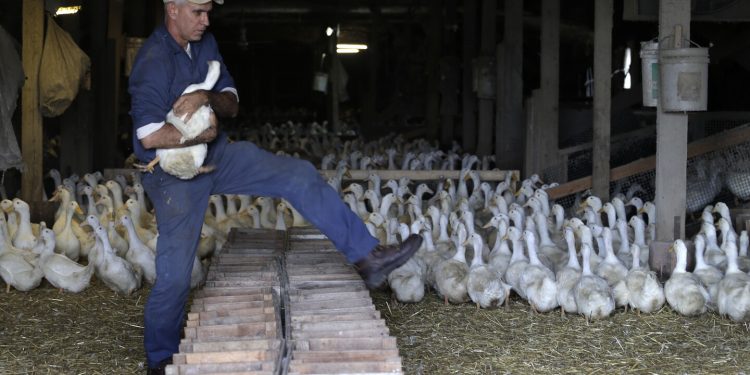New York (AP) – Long Island, in New York, was once synonymous with “duck” in the culinary world. She is now likely to lose her last commercial farm.
THE avian flu epidemic which led to the massacre of millions of birds in American poultry farms and increases the price of eggs struck the Crescent Duck Farm this week, which led the federal authorities to order the destruction of the entire herd of exploitation.
Doug Corwin, whose family has had the farm of around 140 acres since the 1640s, said on Friday that a slaughter over several days of around 100,000 birds had been completed in the barns now quarantined in Aquebogue.
Its remaining staff will carefully disinfect the facilities, a process that could take months.
“We are simply stunned right now,” Corwin, 66, said on Friday by phone. “It’s a very, very sad period. We do our best to get there, one step at a time.
He said that the family will have to take into account the future of the fourth generation company, created in 1908 and nestled in the midst of the vineyards and agricultural land of North Fork in Long Island, about 129 km east of Manhattan.
Corwin said it was forced to dismiss 47 of the 75 farm employees, many of whom had been working there for decades, while farm income collapsed.
“If duck farming was not an option, I’m not sure what we would do,” he said. “We are not really ready to do something else.”
Long Island was once a Duck production center In the United States, thanks to its abundance of fresh rivers, its favorable climate and proximity to the big cities of the East Coast.
At its peak in the early 1960s, the region had more than 100 farms, producing up to 7.5 million birds per year, or about two -thirds of national duck production.
Crescent Duck Farm has been the only exploitation of the island for almost a decade, due to higher operating costs, stricter regulations and the increasingly spreading of the suburbs.
Today, the farm provides almost 4 % of all the ducks sold in the country, supplying restaurants in the Northeast and beyond, including a number of high-end establishments in New York, said Corwin .
The key to its longevity lies in the quality of its ducks, which, according to him, have a thick and fleshy chest and just enough skin fat to keep them tender and humid during cooking.
“The only way for us to survive Long Island is to create a different duck from our competitors,” said Corwin.
Following the epidemic, the farm was authorized to keep several thousand cane eggs, which, he hopes, will help rebuild its herd and preserve the distinctive genetics perfected over the generations.
Quarantine eggs will first be disinfected and out -of -site hatching, with regular tests to detect any sign of the virus.
But Corwin said it was reluctant to restart without federal approval for poultry vaccination – one thing to which large industrial farms are opposed because of its impact on international sales.
Without vaccination, he said, small farms will continue to run the risk of total ruin.
Even now Corwin said he didn’t know exactly how the virus had entered the installation closely controlled after noticing signs that some birds did not go last week.
The farm, he explained, imposed strict protocols to prevent infection, because avian flu has ravaged poultry farms worldwide.
The cases where this avian influenza strain attacks humans are rare. Until now, 67 confirmed human cases and death has been reported in the United States, according to federal health officials. Boat households have been reported in several states. Infections in commercial herds, however, became more common. At least 13 million birds have been infected in only the past 30 days, according to the USDA, and a handful of farms are affected every day.
“We had identified the weaknesses and all tightened,” deplored Corwin. “It was not enough, I guess.”
___
Follow Philippe Marcelo on Twitter.com/philmarcelo.


